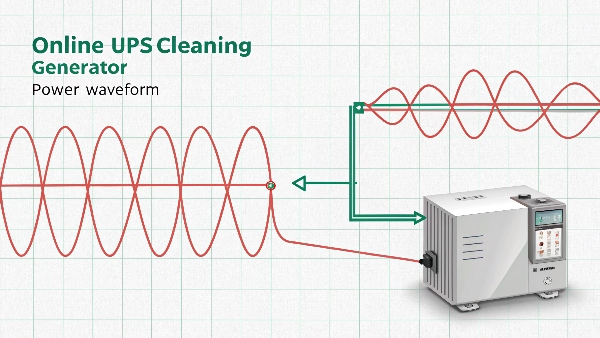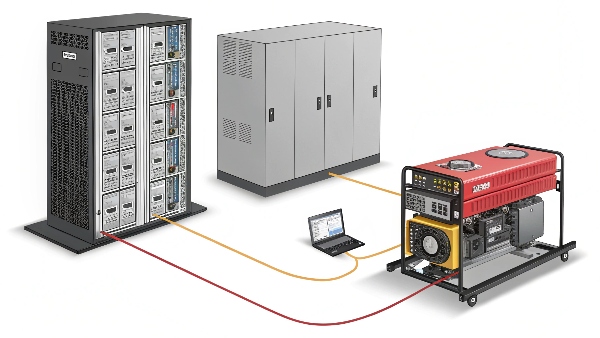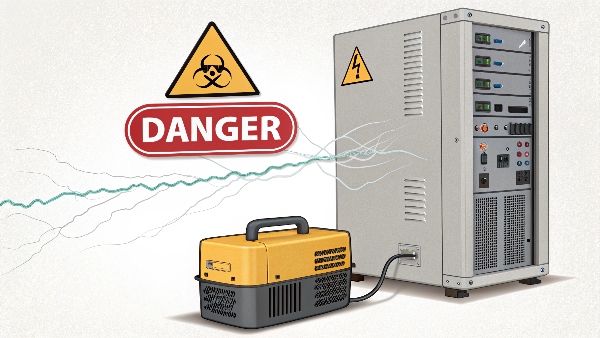Your generator runs, but the UPS keeps clicking annoyingly? This "thrashing" means your UPS is rapidly switching, potentially wearing it out and risking your connected equipment.
UPS thrashing on generator power often happens because the generator's output – its voltage or frequency – is unstable or outside what the UPS considers acceptable. This makes the UPS constantly switch between using generator power and its own battery, trying to protect your devices.

Transition Paragraph:
This is a frustrating problem I've seen many times. You've invested in both a generator and a UPS for complete power security, yet they seem to be fighting each other. At Daopulse, we understand that a generator can provide an uninterruptible power supply with an additional input power source, but making them work smoothly together is key. UPS thrashing is a clear sign that this harmony is missing. Let's look into why this happens and what you can do about it.
Will an UPS clean up generator power?
Worried your generator's output isn't stable enough for sensitive devices? Fluctuations can cause damage or malfunctions. A quality UPS can be the solution you need for clean, reliable power.
Yes, a good UPS, especially an online double-conversion type, will effectively "clean up" generator power. It takes the potentially unstable generator output and rebuilds a perfect, stable sine wave to power your sensitive equipment, protecting it from irregularities.

Dive deeper Paragraph:
A common reason for using a UPS with a generator is precisely for its power conditioning capabilities. Not all generators produce perfectly clean power, especially non-inverter types or when under varying loads. This "dirty" power can have voltage spikes, sags, frequency variations, or harmonic distortion.
- Online (Double-Conversion) UPS: This is the best choice for cleaning generator power. As I've designed systems at Daopulse for over 10 years, I always recommend online UPS units when a generator is involved. It constantly converts AC from the generator to DC, then back to a pure AC sine wave. Your equipment always runs on this perfectly regenerated power, completely isolated from generator output issues. This is how a generator can provide an uninterruptible power supply with an additional input power source that is then perfected.
- Line-Interactive UPS: These can correct minor voltage fluctuations without switching to battery. But, they might struggle with more significant frequency variations or severe waveform distortions from a generator, potentially leading to thrashing.
- Standby (Offline) UPS: This type offers minimal power conditioning and will likely switch to battery frequently if the generator power is not very stable, or it might pass the "dirty" power through.
So, while an online UPS can clean power, if it's thrashing, it might be due to its sensitivity settings being too tight for the generator's typical output range, even if the power isn't "dirty" enough to damage equipment.
| UPS Type | Generator Power Cleaning Capability | How it Works | Likelihood of Thrashing |
|---|---|---|---|
| Online (Double-Conv.) | Excellent | Constantly regenerates power, isolates load from input | Low (if configured right) |
| Line-Interactive | Moderate | Corrects voltage sags/swells; passes frequency/waveform largely unchanged | Medium to High |
| Standby (Offline) | Minimal | Passes generator power directly unless out of tolerance, then to battery | High |
Which is better, UPS or generator?
Unsure whether to get a UPS or a generator for power outages? Making the wrong choice can leave your critical systems unprotected. They serve different but equally important roles.
Neither a UPS nor a generator is universally "better"; they fulfill different needs. A UPS provides instant, short-term battery backup and power conditioning. A generator offers long-term power but has a startup delay. Often, they are best used together.

Dive deeper Paragraph:
I often get asked this question by clients, like Mr. Li, a Procurement Manager at a Hospital Infrastructure Company. The truth is, UPS systems and generators are designed for different aspects of power protection. A UPS is like a sprinter – it reacts instantly. When utility power fails, the UPS provides immediate power from its batteries, preventing any interruption to your connected devices. This is crucial for sensitive electronics like servers, medical equipment, or data storage that can't tolerate even a millisecond of downtime. The UPS also conditions power, protecting against sags, surges, and noise.
A generator, on the other hand, is like a marathon runner – built for endurance. It can provide power for hours or even days, as long as it has fuel. However, generators take time to start up and stabilize. This delay is where the UPS proves essential. The idea that a generator can provide an uninterruptible power supply with an additional input power source is central here; the generator extends the runtime significantly after the UPS has bridged the initial gap. For ultimate protection, especially in critical facilities, the combination of a UPS and a generator is the gold standard. The UPS handles the immediate switchover and power cleaning, and the generator handles the long haul.
| Feature | UPS (Uninterruptible Power Supply) | Generator |
|---|---|---|
| Response Time | Instantaneous (milliseconds) | Seconds to minutes |
| Runtime | Short-term (minutes to a few hours) | Long-term (hours to days, fuel dependent) |
| Power Quality | Conditions power (especially online type) | Can be variable, may require conditioning |
| Primary Goal | No-break power, clean power | Extended power during outages |
| Noise Level | Quiet | Can be noisy (depending on model & enclosure) |
| Fuel | Stored battery energy | Diesel, natural gas, propane, gasoline |
What is the lifespan of a UPS power supply?
Your UPS is a silent guardian, but it won't last forever. An unexpected UPS failure during an outage defeats its purpose. Knowing its lifespan helps plan for timely replacement.
Typically, UPS batteries last 3-5 years, while the UPS unit itself (the electronics) can last 7-10 years or more. Lifespan depends on usage, environment, battery type (lead-acid vs. lithium), and maintenance.

Dive deeper Paragraph:
The lifespan of a UPS system has two main components: the batteries and the electronic components. Batteries are consumables. For traditional VRLA (Valve Regulated Lead-Acid) batteries, which are common in many UPS systems we've supplied at Daopulse, a typical replacement cycle is 3 to 5 years. This can be affected by ambient temperature (higher temps shorten life), the number of discharge/recharge cycles, and the depth of discharge. If a UPS is thrashing frequently due to generator incompatibility, this constant switching to battery will drastically reduce battery lifespan.
Our newer lithium-ion battery UPS solutions offer a longer lifespan, often 8-10 years or more, and tolerate more cycles and higher temperatures better. The UPS electronics usually last longer, often 7-15 years, but can also be affected by harsh environments or power quality issues if not properly protected. Regular maintenance, including battery checks and ensuring proper operating conditions, is key to maximizing the life of your UPS. When a generator can provide an uninterruptible power supply with an additional input power source, ensuring the UPS is healthy enough to handle that input and perform its duties is paramount. Frequent thrashing is a warning sign that can prematurely age your UPS.
| Factor | Impact on Lead-Acid Battery Life | Impact on Lithium Battery Life | Impact on UPS Electronics |
|---|---|---|---|
| Ambient Temperature | High temp shortens significantly | Less sensitive, but extremes bad | High temp shortens life |
| Discharge Cycles | Limited number of deep cycles | Many more cycles possible | Minimal direct impact |
| UPS Thrashing | Severely reduces lifespan | Reduces lifespan, less severe | Can stress components |
| Input Power Quality | Indirect (more cycles if bad) | Indirect (more cycles if bad) | Can stress components |
| Load Level | Higher load = shorter runtime/life | Less impact than lead-acid | High load = more heat |
| Maintenance | Crucial for early detection | Important for system health | Important for longevity |
Will a generator damage my electronics?
Concerned that connecting electronics directly to a generator might fry them? Unstable power can indeed be a hidden danger. Understanding this risk is key to protecting your valuable equipment.
Yes, a generator can damage sensitive electronics if its power output is unstable or "dirty" and no UPS is used to condition it. Fluctuations in voltage, frequency, or high harmonic distortion from a generator can harm modern electronic components.

Dive deeper Paragraph:
While generators are invaluable during outages, their power output isn't always as clean or stable as utility power. Here's why direct connection can be risky:
- Voltage Fluctuations: When a generator starts, stops, or when large loads are switched on or off, its output voltage can surge or sag significantly. These deviations can stress or damage electronic power supplies.
- Frequency Variations: Some generators, especially less sophisticated ones, may not maintain a precise 50Hz or 60Hz frequency. Sensitive equipment relies on stable frequency.
- Harmonic Distortion (THD): Generators can produce "dirty" power with a high Total Harmonic Distortion1. This distorted waveform is not ideal for electronics designed for a clean sine wave.
As a manufacturer at Daopulse, I've seen cases where clients tried to save money by omitting a UPS, only to face costlier equipment failures. An online double-conversion UPS2 is the best defense here. It completely isolates your electronics from the generator's output, using the generator merely as an energy source (an additional input power source) to create perfectly clean power. Even if the generator power is poor, the UPS ensures your devices only see stable, pure sine wave electricity. This protective layer is vital for ensuring the longevity and reliability of your electronics when running on generator power.
| Generator Power Issue | Potential Impact on Electronics (Direct Connection) | How Online UPS Protects |
|---|---|---|
| Voltage Sags/Surges | Component stress, data corruption, shutdown, damage | Regulates output voltage to a precise, stable level |
| Frequency Instability | Malfunction, timing errors, damage to motors/clocks | Outputs a fixed, stable frequency (e.g., 50/60Hz) |
| High THD (Dirty Power) | Overheating, inefficiency, malfunction, premature failure | Regenerates a clean sine wave, eliminating harmonics |
| Startup/Shutdown Transients | Large voltage/frequency swings | Isolates load completely from these transient events |
| Electrical Noise | Interference, data errors | Filters out noise, providing clean power |
Conclusion
UPS thrashing on generator power signals an incompatibility. To ensure your generator reliably acts as an additional power source, use a quality online UPS correctly configured for your generator's output.
-
Understanding Total Harmonic Distortion is crucial for protecting your electronics. Explore this link to learn how it affects performance and reliability. ↩
-
A double-conversion UPS is essential for clean power. Learn how it safeguards your devices from generator issues by checking this informative link. ↩

